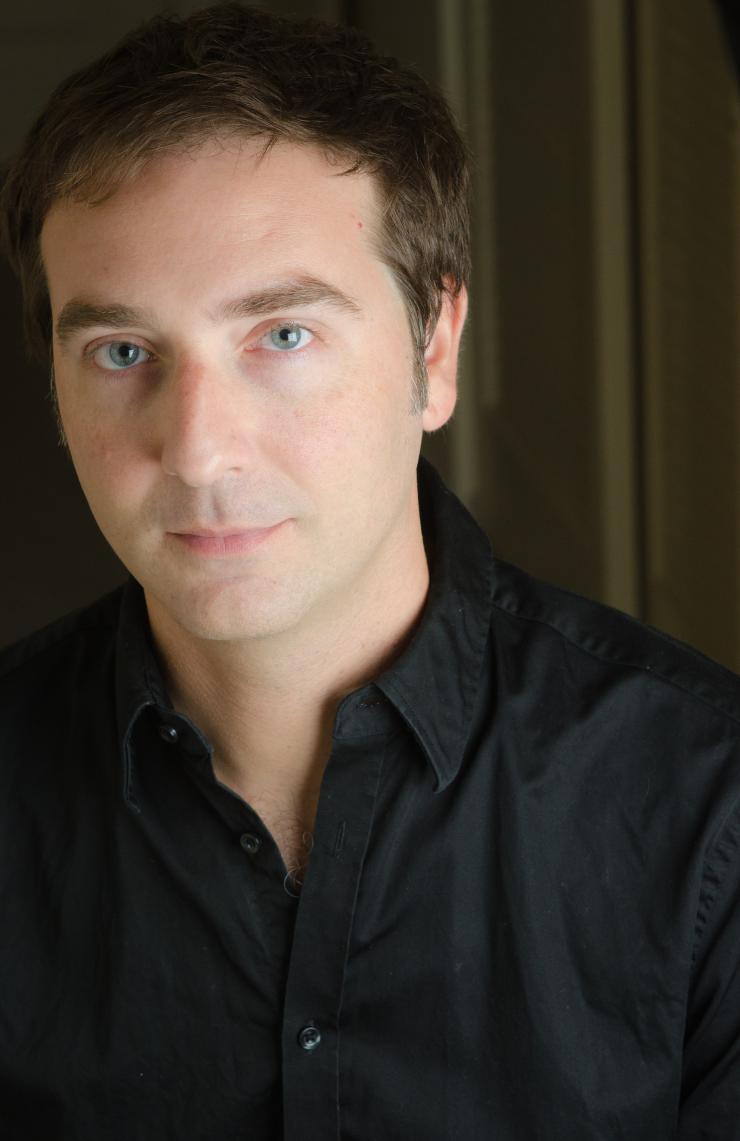Boxing from the Inside
Brett Neveu and the Magnetic Presence of the Ring

While he is no stranger to national attention, something new has been added to Brett Neveu’s resume in 2014—New York playwright. And his Chicago ensemble has newly opened a New York outpost. In a chat just before the opening of the New York run of his Chicago-birthed creation The Opponent at 59E59 Theaters in early August 2014, Neveu (pronounced neh-view) elaborated on the genesis of this play and its role as the inaugural offering of A Red Orchid NYC—the NYC-based production “home” for Chicago’s A Red Orchid Theatre.
The wonder of Neveu’s creation is its spare and pure power, drawing from the drama of the ring, but not depending upon it for delicate and layered theatrical storytelling.
Sparring about Life
From the top, Neveu’s two hander involving a boxer, Donell (Kamal Angelo Bolden), and his ex-boxer trainer Tre (Guy Van Swearingen) uses boxing as metaphor in a surprisingly light-handed way. You watch them spar, fighter and trainer, and the play is in part about that dance. The play is also about relationships—father and son, mentor and mentee—and about class and aspiration. In the words of Tre, “It don't matter why you fall. It only matters if you get up." Despite the powerful resonance of gloves tapping gloves and grunts of physical exertion, it is clear that these conversations about life, risk, challenges, and character could be taking place between two men in coffee shop. The wonder of Neveu’s creation is its spare and pure power, drawing from the drama of the ring, but not depending upon it for delicate and layered theatrical storytelling.
Knowing When to Get Out
Neveu is based in Chicago and teaches at Northwestern University, but has spent time away over the past few years. He’s had seven world premieres at A Red Orchid, where he and heavy weights like Michael Shannon are ensemble members. One of his plays Do The Hustle was done at Writers Theatre in Glencoe, Illinois, and almost sold to television, initiating a Los Angeles phase of his life that ended in 2011 with a return to home base.
The five years Neveu spent in LA were trying. “I wasn’t really trying to get staffed because I was out of town so much, but I was trying to sell a series, and came close a couple of times, and got frustrated with the business.” His wife, designer Kristen Neveu, told him, “If you don’t want to write for television, you don’t have to.” The family reassembled in Evanston about a year ago.
Community Creation and Magnetic Presence
The Opponent emerged from an initial impulse involving Neveu’s father—he and his dad watched a lot of boxing, especially fight nights, when he was a kid—and the chance to spend time to develop a nugget of an idea at the Center Theatre Group in LA.
Neveu approached another sport, football, in his 2008 play Gas For Less, in which he wrote about a group of characters that shared “a sort of love for football,” but he hadn’t written it “from the inside” of the sport. An article he read about boxers who are set up to face bigger fighters inspired him to give that kind of inside treatment to a new play about boxing.
They have their own aspirations. They travel all over the place, but they’re also set up against guys that are much better than they are, or have better training, better facilities, all that stuff. I thought that was sad and interesting, and I could relate, because of my LA experience. I wondered: how bad did I want something that others wanted for me? How was I participating in my own dream, or was I participating in someone else’s dream? And so that kind of bled into the script.
He was asked to join an annual writer’s group in LA at the Center Theatre Group. They offered to provide experts on the subject matter of the plays in development. They found an Australian former professional fighter, Justin Fortune, who owns a gym in LA. “He once had a shot at a title. He made it through nine rounds and then he lost.” The story, Neveu continued, isn’t so much about the loss as it is about what the man did with that loss. “Justin got beat, but he held his own for nine rounds. That’s what his claim to fame is, that’s why people want him around, that’s why they go to his gym—because he’s that guy who fought that guy and almost won.”
Time spent at Justin’s gym that proved pivotal to his play’s development.
He let me hang out in the gym, just wandering around taking notes. At one point one of the guys I was talking to said “hey, so-and-so is coming in, he’s really good.” When he came in, and the whole gym just parted. Then he got into the ring and everybody just casually gathered around to watch. He fought two guys; beat the crap out of them. And I looked around, and everybody had just stopped training.. And I thought: oh, my god, this is the show. There’s that magnetic presence of the ring.
A Red Orchid Chicago and A Red Orchid New York: Two Years Better
The Center Theatre Group held onto the rights to the play for a little while, and then released them to Neveu for his home theater in Chicago. There was a reading in Chicago in 2011, and someone who had seen Kamal Angelo Bolden in Chicago’s 2009 production of The Elaborate Entrance of Chad Diety suggested him for the role of the fighter Donell. They arranged for a table read with Guy Van Swearigen, for whom the role of Tre was written. “The two of them just sat at a table with ensemble members and Karen Kessler the director, and Kamal knocked it out of the park.”
The play opened to great reviews in 2012, leading the company to consider it for a New York production. Two shows that originated at A Red Orchid had traveled in in the past ten years to New York’s Barrow Street Theatre, but not as Red Orchid productions. Neveu recalled company discussions about making the move with this show. This one had good potential to travel, the ensemble discussed, “because Guy’s in it and it is two characters and a unit set and doesn’t require a lot of technical elements. But it was a little bit of a pipe dream because we didn’t know what we could do, it was just talk.”
A series of conversations and coincidences then unfolded, as is often true in theatrical stories. A friend of a friend, Roberta Pereira, read the script and was enthused. Pereira and Shannon championed the idea, and the company was on board. Elysabeth Kleinhans and Peter Tear at 59E59 were supportive. Tear knew the company’s work in Chicago and opened all the doors, giving Neveu his choice of space.
Bisno and Pereira, as Bisno Productions, served as executive producers. Bisno co-founded Chicago’s Roadworks Productions in 1992, which “had a big explosive impact on Chicago theater.” She knew the company and the ensemble members, and, according to Neveu, became invested artistically “in making sure this was something that maintained its integrity as it transferred.”
When asked if there had been many tweaks between the Chicago and New York productions, Neveu mused: “Blocking adjustments were made to fit the new space. But the biggest change is the depth of performance that has grown from the two years away from the show. The actors have become two years better.”
Choreographing Movement and Language and Silence
In plays that involve intricate choreography, the movement inherent to the storytelling can be a threat to communicating all the story’s dimensions. Some may stop at watching bodies in motion. “That’s a danger I think with a play like this.”
The Opponent’s extensive fight choreography is not balletic or large scale, but it is full of nuance and sounds. There are sub scenes made up of physical interactions between the characters that don’t exist in the script. For Neveu, this made the sound design even more crucial: “It’s the sound. It’s the glove hitting the pad that draws the audience into the action of it.”
There is a moment of silence when Tre rolls hand wrap (the cloth wrap that covers a fighter’s hands under the gloves) that is absolutely brave and riveting. Both men stand silent, motionless, except for the spooling and wrapping, letting all the action that has transpired sink in. This moment was a favorite part of the play for Neveu: “after everything has happened, all the physicality, just to be left with two still dudes.”
Analyzing the placement of certain moments of levity reveals some of the structure of the play:
Both acts are two ten round fights. And where that humor lands is where in a fight you would expect people to sort of settle in, as they gauge each other. When you’re watching a fight, it’s the point where the fighters, in round four or five, are settling back, trying to relax. The humor is a little like “taps”—they try to out joke each other, but the more experienced fighter gets a couple of good jabs in, just to see, to check the reach of their opponent.
The scoring of the script became keeping track of these fight rounds. “I had to track how each round was going, to make sure that they were even on the card. So by the time we get to the end of the play, the fight has become similar to Tre’s biggest fight when he lost in the ninth round. It has to be Donell’s choice whether he will become another Tre, or a guy who can go home to his wife and kid and just do something else.”
Process and Development: There are Stories in the Story
“I’m often more interested in the development than I am in the production. I like that experience and that journey often more than I like going to the show.” To focus solely on the production can make one miss out on the meat of the experience:
So many playwrights focus so hard on the productions and they don’t give a positive thought to that time spent talking and thinking. It’s like worrying about your kids getting into college and you miss all that time going to the park or taking the kid out to dinner, or watching TV. Tre says, “you’re going to remember to enjoy yourself before the fight.” And that’s it. Enjoy yourself before the fight, because the fight itself is nothing if you don’t enjoy yourself.









Comments
The article is just the start of the conversation—we want to know what you think about this subject, too! HowlRound is a space for knowledge-sharing, and we welcome spirited, thoughtful, and on-topic dialogue. Find our full comments policy here